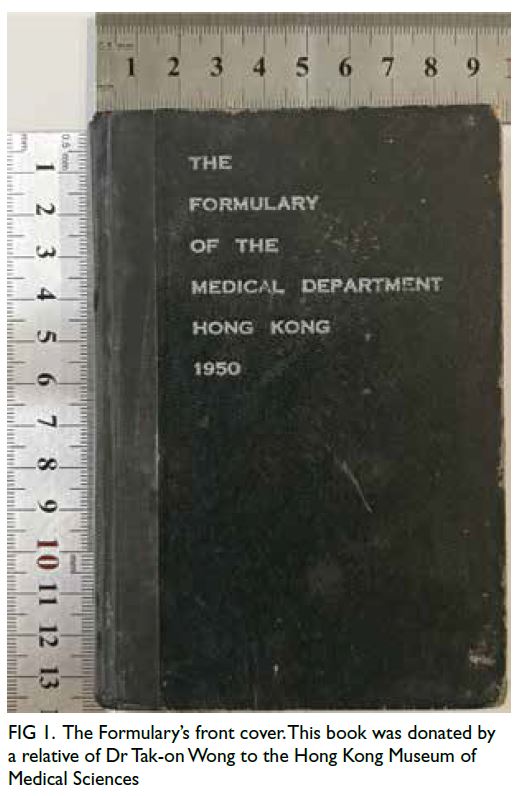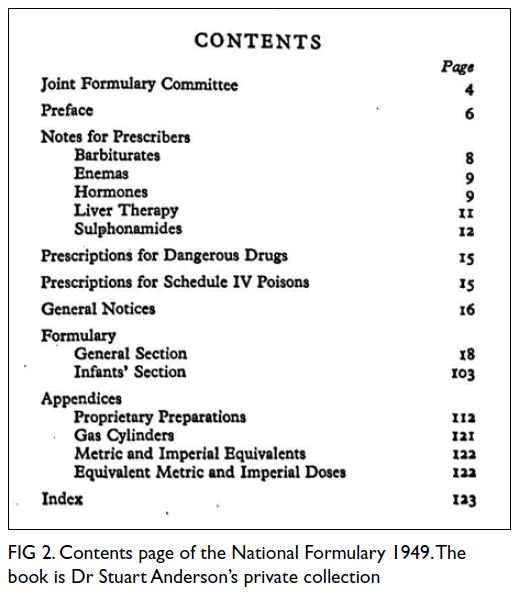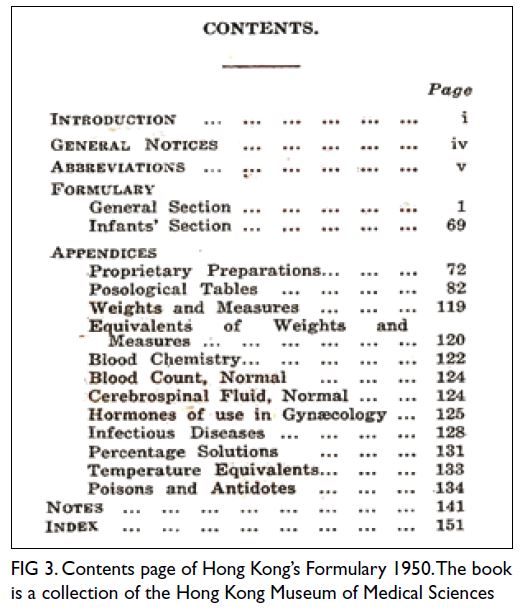© Hong Kong Academy of Medicine. CC BY-NC-ND 4.0
REMINISCENCE: ARTEFACTS FROM THE HONG KONG MUSEUM OF MEDICAL SCIENCES
The Hong Kong Formulary of 1950
Patrick Chiu, FRPharmS, FRHS
Guest Author, Education and Research Committee, Hong Kong Museum of Medical Sciences Society
Introduction
Hong Kong’s first formulary (the Formulary) was
published in December 1949, becoming effective in
January 1950 (Fig 1). It was compiled by the Reverend
Dr Kenneth Harrison Uttley (1901–1972), chairman
of the Formulary Committee and a talented linguist,
fluent in Cantonese, Portuguese and English. The
son of Anglican missionaries, Dr Uttley spent his
childhood in Brazil before returning to England
to study divinity at Gonville and Caius College,
University of Cambridge on a scholarship. He later
switched to medicine.1

Figure 1. The Formulary’s front cover. This book was donated by a relative of Dr Tak-on Wong to the Hong Kong Museum of Medical Sciences
After joining the Government Medical Service
in Hong Kong in 1929, Dr Uttley was posted as a
district medical officer to the New Territories. Five
years later, he earned his doctorate in medicine, also
from Cambridge, and was promoted to senior medical
officer in 1941. During the Japanese occupation, Dr
Uttley was the head physician at the civilian Stanley
Internment Camp, where he was also interned.2
Postwar, Dr Uttley rejoined the government
and continued to hold senior positions, eventually
becoming the Deputy Director of Medical Services
within the Medical and Health Department in May
1950.3 In 1955, he left Hong Kong for Antigua in the
British West Indies, where he worked as the Chief
Medical Officer until 1966. He also served as an
ordained priest in the Anglican Church, and, upon
retirement, returned to England to serve as the vicar
of Pyrton, Oxfordshire, until his passing in 1972,
aged 72 years.
A timely formulary
The idea of creating a comprehensive local drug
formulary was first conceived by several medical
officers, including Dr Uttley, while they were interned
at the Stanley Internment Camp. The Formulary
was subsequently compiled in the 4 years after the
Second World War. The 169-page hardcover book
was published in December 1949 by the government-appointed
printer and publisher, the Macanese family-owned
Noronha & Co Ltd. In the foreword, Dr Uttley
articulated the rationale behind the Formulary:
“The purpose was to produce a volume of convenient size that could be used by the medical student, pharmacist, general practitioner and medical officer.”4
The Formulary came at a crucial point in
Hong Kong’s medical history, in the face of a severe
shortage of qualified doctors. Between 1945 and 1949, 1.26 million of the 1.86 million former Hong
Kong residents who had fled during the Japanese
occupation returned.5 In addition, 400 000 mainland
refugees came to Hong Kong between 1949 and June
1950 to escape the Chinese Civil War.3 6 Although
The University of Hong Kong had resumed medical
education in 1946, the new practitioners would not
join the workforce until 1952.7 Dr Uttley, having
experienced a similar population surge from 1937
to 1941 when Hong Kong’s population swelled from
500 000 to 1.8 million, was prepared to address the
challenges posed by the migration of the late 1940s.8 9 10 11
First, the newly arrived postwar colonial
governor, Sir Alexander Grantham, was convinced by
senior medical officials, including Dr Uttley, to create
more than 20 government medical positions. This
brought the total number of public-sector doctors in
Hong Kong from 104 to 125—a 20% increase to cope
with the 400 000-population growth to 1.9 million,
equating to approximately 1 doctor per 22 000
residents, from 1949 to 1951.3 5
Second, the Director of Medical Services, Dr
Isaac Newton, negotiated an agreement with the
Hong Kong and China branch of the British Medical
Association and the Hong Kong Chinese Medical
Association to appoint, on a purely temporary basis,
internationally qualified doctors who were ineligible
for registration in Hong Kong (such as those who had
trained in China), under the Medical Registration
(Amendment) Ordinance of 1949.5
Consequently, in 1949, 36 of the 127 positions
(28%) were filled by mostly mainland medical
practitioners, who could only practise under
the supervision of a locally trained clinician.6 By
March 1952, 98 out of 141 medical officer and
assistant medical officer positions (70%) were filled
by individuals whose qualifications could not be
officially registered in Hong Kong.7
Third, Dr Uttley recognised the differing
training backgrounds of Commonwealth and
mainland medical practitioners and those who were
British or locally qualified. The timely publication
of the Formulary was an attempt to bridge this gap.
It provided guidance on prescribing practices and
familiarised the mainland-trained practitioners
with locally available medicines, whether dispensed
or manufactured by public hospital pharmacies,
the Central Medical Store, or imported proprietary
brands.
A local version of the National
Formulary 1949
Clement Attlee (1883–1967) served as Britain’s prime
minister from 1945 to 1951. During his tenure, the
National Health Service (NHS) was created. Funded
by general taxation, the NHS launched in July 1948,
offering comprehensive healthcare and prescription
drugs to all citizens regardless of income, and
providing free medical care in both community and
hospital settings.
In anticipation of the NHS, a Joint Formulary
Committee of the British Medical Association and
the Pharmaceutical Society of Great Britain was set
up. The committee was tasked with preparing a new
drug formulary for use by community physicians
and pharmacies contracted to the NHS. The first
edition of the National Formulary (NF) 1949, later
renamed the British National Formulary in its fifth
edition in 1957, was an extension of the National
War Formulary published in 1941. The NF, a pocket-sized
hardcover book, listed recipes and formulas
primarily for medicines that could be prepared
by community pharmacies, reflecting the wide
use of extemporaneous preparations in the mid-20th century (Fig 2).12 A brief methodology in the
preparation of extemporaneous preparations was
described in the NF, with details separately published
in the 1949 edition of the British Pharmaceutical
Codex.13

Figure 2. Contents page of the National Formulary 1949. The book is Dr Stuart Anderson’s private collection
As primary care was the NF’s focus, the general
section covered drugs frequently prescribed for the
public, such as barbiturates, enemas, hormones, liver
therapies and sulphonamides (Fig 2). Requirements
to prescribe dangerous drugs, such as diamorphine
(heroin), were included for restricted use, with
reimbursement in the form of a dispensing fee to
retail pharmacies.12 Formulas relating to paediatrics
were listed separately. By the 1970s, most of the
extemporaneous preparations had been replaced by
prepackaged oral or other dosage forms and supplied
by local generic manufacturers.
Conclusion
The Formulary differed from the NF, both in its
purpose and the audience it served, despite sharing
many formulas and recipes. Unlike the NF, the
Formulary was used exclusively by physicians, many
of whom were trained on the mainland and served
in the Medical Department of Hong Kong during the
late 1940s and 1950s.
The Formulary’s appendices were tailored to
meet these physicians’ practical needs and included
posological tables, references for blood chemistry,
normal blood counts and normal cerebrospinal
fluid. There were specific sections on hormones for
use in gynaecology, including oral contraceptives,
and guidance on managing infectious diseases. The
Formulary also featured critical information on
poisons and antidotes, equipping practitioners with
the essential tools to manage emergencies (Fig 3).

Figure 3. Contents page of Hong Kong’s Formulary 1950. The book is a collection of the Hong Kong Museum of Medical Sciences
The last edition of the Formulary, published by
the Hong Kong Department of Health in 1989, when
the Hospital Authority was established in 1990, can be
considered a legacy of Dr Uttley’s work. In 2003, the Hospital Authority embarked on developing its drug
formulary, and since 2005, the Hospital Authority
has published its own Drug Formulary, organised
according to the British National Formulary’s
therapeutic class system.14
The Chronic Disease Co-Care Pilot Scheme,
part of Hong Kong’s primary health initiative,
expanded its basic-tier drug list to 114 items on 1
August 2025.15 Further expansions are planned under
the newly developed Community Drug Formulary
(CDF), slated for publication in late 2025.15 The
CDF will provide participating family doctors with a
broader range of drug choices to cater to the varying
clinical prescription needs of participants in the
scheme. In this way, the CDF continues the legacy
established by Dr Uttley’s pioneering work on the
original Formulary.
Acknowledgments
The author expresses gratitude to Dr Stuart Anderson,
Emeritus Professor of Pharmacy History at the London
School of Hygiene and Tropical Medicine, United Kingdom.
Dr Anderson, the author of Pharmacy and Professionalization
in the British Empire, 1780–1970 (Palgrave, 2021), provided
numerous valuable suggestions regarding the British National
Formulary of 1949.
References
1. Hong Kong Government Reports Online (1842-1941). Civil Establishment. In: Hong Kong Blue Book for the Year 1935. Hong Kong: Noronha & Co Ltd and Government Printers; 1936.
2. Chan-Yeung MM. A Medical History of Hong Kong: 1942-2015. Hong Kong: The Chinese University of Hong Kong
Press; 2019: 32-3. Crossref
3. Medical and Health Department. Annual Departmental Report by the Director of Medical and Health Services for the Financial Year 1950-1. Hong Kong: Hong Kong Government; 1951.
4. The Formulary of the Medical Department Hong Kong. Hong Kong: Noronha & Co Ltd, Government Printers & Publishers; 1950: i-iii.
5. Medical Department. Hong Kong Annual Report of the Director of Medical Services for the Period 1st January 1948–31st March 1949. Hong Kong: Hong Kong Government; 1949.
6. Medical Department. Hong Kong Annual Report of the Director of Medical Services for the Year Ended the 31st March 1950. Hong Kong: Noronha & Co Ltd and Government Printers & Publishers; 1950.
7. Medical Department. Hong Kong Annual Departmental Report by the Director of Medical and Health Services for the Financial Year 1951-2. Hong Kong: The Government Printer; 1952.
8. Hong Kong Government Reports Online (1842-1941). Population and Vital Statistics, 1937. In: Hong Kong Bluebook for the Year 1937. Hong Kong: Noronha & Co Ltd and Government Printers; 1938.
9. Hong Kong Government Reports Online (1842-1941). Population and Vital Statistics, 1938. In: Hong Kong Bluebook for the Year 1938. Hong Kong: Noronha & Co Ltd and Government Printers; 1939.
10. Hong Kong Government Reports Online (1842-1941). Population and Vital Statistics, 1939. In: Hong Kong Bluebook for the Year 1939. Hong Kong: Noronha & Co Ltd and Government Printers; 1940.
11. Hong Kong Government Reports Online (1842-1941). Population and Vital Statistics, 1940. In: Hong Kong Bluebook for the Year 1940. Hong Kong: Noronha & Co Ltd and Government Printers; 1941.
12. The National Formulary 1949 [editorial]. London: British Medical Association and Pharmaceutical Press; 1949: 6.
13. British Medical Association. Preface, National Formulary 1949. London: British Medical Association and Pharmaceutical Press; 1949: 6.
14. Hospital Authority. HA Drug Formulary. Available from: https://www.ha.org.hk/hadf/en-us/Updated-HA-Drug-Formulary/Drug-Formulary.html. Accessed 25 Aug 2025.
15. Hong Kong SAR Government. Government expands drug list of Chronic Disease Co-Care Pilot Scheme [press
release]. 1 Aug 2025. Available from: https://www.info.gov.hk/gia/general/202508/01/P2025073100584.htm. Accessed 25 Aug 2025.

